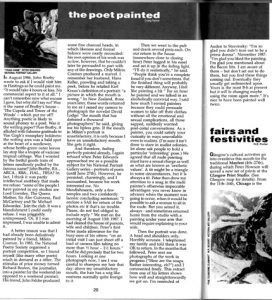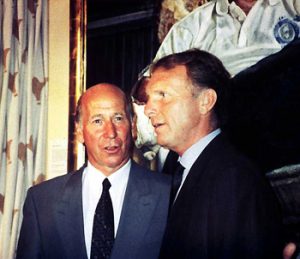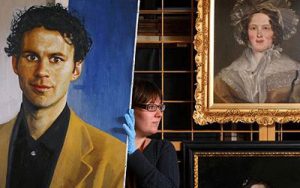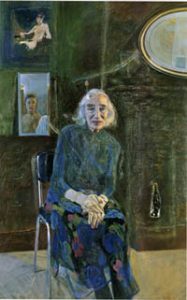Articles include:
Tuesday 31st May 2011
The Poet Painted – Craig Raine. Galleries Magazine Vol. V11 No.12 May ’90 ISSSN 0265-7511

Friday 28th January 2011
Independent.co.uk article.
THE SITTER’S TALE: Sir Bobby Charlton

Bobby Moore and Bobby Charlton just after Moore’s unveiling of the Edwards portrait on the 30th July 1991, commemorating the 25th anniversary of England winning the World Cup.
http://www.independent.co.uk/arts-entertainment/the-sitters-tale-sir-bobby-charlton-1118666.html
Friday 16th January 2009
Telegraph.co.uk article.
Ryan Giggs portrait to be hung in National Library of Wales

Dr Paul Joyner, Head of Art Acquisitions, with Ryan Giggs portrait Photo: WALES NEWS SERVICE
Observer 2006

Dr James Hamilton – University Curator – November 2005
PETER EDWARDS
Every age and nation produces its crop of portrait painters whose work comes to define the era. It may not be clear for many years where Peter Edwards comes in the history of twenty-first century British portrait painting, but wherever it is it won’t be a footnote; more likely a chapter. Edwards is well known already through his work in the National Portrait Gallery: his portraits of Sir Bobby Charlton, Seamus Heaney and Kazuo Ishiguro are highly characterised, and especially popular if sales of their postcards are an indication.
The paintings displayed here are part of a series of portraits of poets that Edwards chose to paint: none was made on commission, the usual route for a portrait painter to earn bread and butter. All have an affection and insight suggestive of rich private dialogue. Their paintwork, often sumptuous and surprising – look at the yellow and red streaks in Craig Raine’s shoe – creates a shockwave that is more felt than imagined. In the portrait of Medbh McGuckian the shower of colourful dabs behind the sitter makes the work vibrate about her still centre. As McGuckian herself expresses it in her poem Venus in the Sea, ‘A colour walks around, with people hidden in it.’
While portraits can define the era, the choice of subject tends to define the artist. For his representatives of twenty-first century Britain, Edwards has chosen not lawyers or politicians, but poets, ‘the unacknowledged legislators of the world’, as Shelley reminds us. If the men and women on the walls of the Aston Webb Rotunda were left to legislate for our era, Edwards suggests that they would do so, in Peter Redgrove and Penelope Shuttle’s phrase, while ‘tossing out rainbows’.
Dr James Hamilton
University Curator
List of works
Self Portrait of the Artist Oil on canvas 1981
Kit Wright Oil on canvas 1989
Peter Redgrove and Penelope Shuttle Oil on canvas 1989
Maud Sulter Oil on canvas 1987 -1988
Medbh McGuckian Oil on canvas 1989
Craig Raine Oil on canvas 1988
Wendy Cope Oil on canvas 1989
Study for Marguerite Kelsey Oil on canvas 1992 (on show in display case downstairs)
Portrait of Roger Burman, Pro-Chancellor Oil on canvas 2003
(Commissioned by the University of Birmingham)
Curriculum Vitae
Born: 20 November 1955, in North Wales
Education: Shrewsbury College of Art & Technology Art Foundation 1974 – 1975
Gloucestershire College of Art & Design BA Hons Fine Art 1975 – 1978
Group Exhibitions include:
1994 BP Portrait Award, National Portrait Gallery
1993-1994 The Portrait Now, National Portrait Gallery
2000 The Garrick/Milne Award, Christies
2002 Signs of Life, Beadleston Gallery, New York
2003 The Garrick/Milne Award, Christies
One Man exhibitions include:
1990-1992 Contemporary Poets, National Portrait Gallery and tour
1996 The River Dee from Source to Estuary, touring exhibition. Jointly funded by the National Library of Wales, Williamson Gallery, Birkenhead & Clywd Fine Arts Trust
2002 From the Studio, Gateway Arts Centre, Shrewsbury, 2002
Awards include:
1994 First Prize, BP Portrait Award, National Portrait Gallery, London
1984 & 1992 Elizabeth Greenshields Foundations, Quebec
Collections include:
Metropolitan Museum of Art, New York
National Museum of Wales, Cardiff
National Portrait Gallery, London
National Library of Wales, Aberystwyth
Ulster Museum, Belfast
National Museums & Galleries on Merseyside, Liverpool
Ferens Gallery, Hull
Williamson Gallery, Birkenhead
Lawrence House Museum, Launceston
Salter’s Company, City of London
South Bank Centre, London
St George’s Hospital, London
Birkbeck College, London
Downing College, Cambridge
Hereford College, Oxford
Jesus College, Cambridge
Sir Brinsley Ford, London
St Andrew’s University
St John’s College, Cambridge
University of St Andrew’s
University College, London
University of Birmingham
To purchase work, contact University of Birmingham Collections: 0121 414 6750.
Marguerite Kelsey, Oil on canvas, 2070 x 1358mm

Statement: This painting depicts Marguerite Kelsey who had been a famous artists model between the wars, and was part of the artistic bohemian scene of Chelsea. She sat for most of the prominent British artists of the inter-war years. she was often an anonymous life model or sometimes her elegant hands would be used when a society sitter was too busy. She was certainly a Muse for a few artists, and there is a famouse portrait of her posing neoclassically on the chaise longue by Meredith Frampton in 1928.
She emigrated to New Zealand at the beginning of the 2nd World War with her new husband, and when he died after a long illness in the 1980s’, she returned to England, penniless and suffering the onset of a crippling rheumatoid arthritis. But she was discovered again by the art world in her Worthing bedsit. Her two “Richards”, Richard Ormond Director of the Royal Maritime Museum Greenwich and Richard Morphet of the Tate gallery London were her link back to the London art scene.
I came across an article in the Telegraph Magazine in 1991 about Marguerite, and how she had sat for her last portrait. I wrote to Richard Ormond mentioned in the piece, and he passed my address on to Marguerite. She replied and so began a correspondence that led me to journey to Worthing, to stay in the same boarding house, 135 Brighton Road Worthing.
The large final portrait was begun in 1992 after I had already completed several small paintings and drawings.
The big painting executed in my then studio in Ellesmere, Shropshire was an attempt to depict Marguerite as I had seen her in Worthing but also distilling all the memories of a lost art world, into the work. There were more sittings in Worthing, and it was during one of these later sittings that she began telling me about sitting as a nude for George Spencer-Watson in the early 1930s. This rang a bell and I remembered I had owned a cheap print since student days in Cheltenham depicting an attractive young woman sitting in a chair. I described the painting with its distinctive fur rug and earrings and she said ” Oh yes dear. That was me”! I later Incorporated the image into the painting. It is in the top left hand corner.
When posing, there would always be a bottle of cheap, warm, not very strong German Riesling to hand. This would be sipped by artist and model throughout the sittings. “this is how we did it in Chelsea – in the art word, dear. White wine doesn’t count as drinking”
I put a bottle into the painting about where it always sat in the fire-place. Painted in some detail i was never happy with it. It seemed too literal – prosaic, so I scraped it off and the resultant “echo” of the bottle seemed more resonant.
There are several thrown paint marks that sit on the surface, and were subsequently glazed over. There is one of these long connecting streaks in the portrait of John Heath-Stubbs in the National Portrait Gallery, and it is a mark making devise that I had been intrigued with since encountering it in Francis Bacon’s Work as an art student. But what was it doing in this painting? It was certainly part of the narrative of the work. Robin Gibson of the National portrait gallery (tongue in cheek)called them “spermatozoa”. And the Art critic McEwen wrote about “my irritating technique”, failing to understand, I felt, that these marks might be part of a story, a sort of hieroglyph of paint. But meaning what? Looking again I see these floating marks as the spirits of all the painters and sculptors who depicted Marguerite, and who are now all dead.
The figure in the mirror is a self portrait representing the artists who had gazed on her, and through them allowed the viewer to see what they saw.
It is a painting about being a model (the seen) and an artist (the seer). Hence the tortuous title.
In 1994 I entered the painting for the BP Portrait Award Competition at the National Portrait Gallery. It won the First Prize.
Marguerite was taken to see the exhibition in London by her two Richards.
Marguerite Kelsey died in a nursing home in Cookham in 1995.
Peter Edwards. October 2005
Portrait of Marguerite Kelsey – October 2005

The Artist’s and Illustrator’s Magazine – October 1990
Without exception, I have established a friendly relationship with the poets I have painted. I think I saw doing their portraits as the first stage in possible future collaborations, where I might base paintings on something they have written or take it as a starting point. I don’t mean straightforward narrative painting or anything like that, but I would like the sort of relationship I have built up with some of the poets to continue and create other paintings. Poetry sparks off a lot of things in the mind.
On the one level I feel that poetry and painting occupy common ground. Not when it is down on oil paint or once it is down in words, but when it is going round and round in the mind. One of the reasons I stopped writing poetry was because I thought it was occupying the same part of my brain as my painting, so I had to jettison one or the other. I am really a painter so the poetry had to go. I still jot down little notes all the time. I did some after I saw Ivor Cutlor and they came out like a poem, about the experience of seeing him. The basic idea I was getting at was that photographs are probably better at capturing the minutiae of expression, things that only last a fleeting moment, whereas when you paint someone for three hours at a time you build this sort of mausoleum in paint. The last line read: “paint is selfish”. Perhaps I was trying to say that the paint has an importance alongside whatever you are actually painting, whereas a photograph is much more submissive to the subject, a painting is still an object almost independent of the image.
My first memories are of drawing. I used to draw incessantly. I would never watch TV. Making images was a very natural thing. I used to try and do as much art as possible at school. Oswestry School was very traditional and trying to explain, at 13 years old, that you wanted to be a painter to people who thought Latin would be extremely useful in your future career was very difficult. I used to skive off to the art rooms when I was supposed to be doing either Combined Cadet Corps or Social Services, I eventually got out of both of them.
I realised quite late on that if you wanted to be an artist you usually want to art school. I was from a non-artistic background living in a non-artistic part of the world. That’s not such a bad thing for me. I still prefer to live in a community where people are just working on the land, you know, ordinary sorts of jobs. I don’t have any great desire to be surrounded by other artists all the time. It is great to come down to London and mix in but there is a side to me that likes to be out of it. When a painting affects me I can’t help but be influenced by it, so I need a certain amount of isolation just to consolidate what I am doing.
I went to Shrewsbury College of Art and Technology to do a Foundation Course and then to Gloucestershire College of Art and Design in Cheltenham. I had an extremely good first year there and, for the first time in my life, people thought I had something. But in the last two years, I suffered a bit. I don’t think I suited an art environment even though the tutors were great. Being in the figurative camp was also quite an important stance to take at art school in the mid-1970s.
My poetry writing started on my foundation course when I suddenly found the one artist who seemed to give me some sort of emotional drive. It was Wilfred Owen, who wasn’t a painter at all/ It was very confusing for me, I was trying to be a painter but the person I admired the most and wanted to emulate was a poet. I could identify with Wilfred Owen, since he came form a very similar background to me, and became obsessed with his life and work. In a way he is the person who made me think I could be an artist.
During the last two years at Cheltenham, my interest in Complementary Studies and poetry grew enormously. I had a tutor called Nick Wright, who was a poet although he kept it quiet. I would go to his house and drink his homemade wine and we would talk about poetry. That was one of the most important things for me at college; the one-to-one thing. I almost needed an emotional attachment to the tutor for it to work. That is what is important with the poets, that there is an emotional link which can be formed simply through knowing their work.
I was a great fan of Tiepolo at art school. I thought the way he portrayed women in particular was amazingly graceful. And Titian, the Venetian thing I suppose. When I was about six, a family friend gave me a book on Rembrandt and a book on Picasso and those were my two main art books as I grew up. Both artists entered my mind quite early on and both stayed there. I first came across Stanley Spencer when my mother got the book Point Counterpoint by Aldous Huxley and on the front was a portrait of Patricia Preece by Spencer. I cam remember looking at the cover of this book for hours. I was just a terrific piece of painting: the face was totally asymmetrical, one eye slightly higher than the other, the stripes on the jumper and the finding of all these flesh tones!
For the first four years after I left college, 1978-82, all my money went on oils. I used to paint on little bits of wood because you could pick up plywood very cheaply. I just slogged away really. But in those years I felt I learnt more about myself than ever before. I mainly did self-portraits, where I used an image of myself as a starting point to work from. They were learning paintings and I almost felt it was more real than what I’d done at college. The only thing of any consequence that happened to me during this period was that Sir Brinsley Ford bought a very small self-portrait on wood at the banquet before the private view of the 1980 Royal Academy Summer Exhibition. And the only reason it was in the exhibition, was that a friend of mine took it along and put what I thought was a wacking great price on it.
In 1982 I was offered a one-day teaching class with a nice bunch of people. I must have been an exasperating teacher. I I did give them a clue it would be a least three clues of how to do it, because in my own mind I might approach it in three different ways. I’ve never held to any dogma, or preconceived ideas. When I paint, if something happens then I follow that line, or if I get frustrated I will throw on a bit paint, break up the surface and start painting again.
If I could walk into a caf© and chat with my choice of painters around today I would like to chat with Auerbach. I have a lot of respect for him. When I first came across his paintings it was quite a shock. I felt almost indignant. “God, there must be around £50 worth of paint in that lump! I don’t make that in a week!” I eventually recognised he is saying something about the surface of a painting that I needed to take in. Certain of the abstract painters have also taught me something about how important a painting is as a surface and as an object.
The Ivor Cutler painting, which ended up as one of the most precise straightforward figurative paintings, actually began as completely abstract. There is a strip down the right-hand side that’s left of the original painting underneath. It’s just swirls of quite think white paint and blue background. I really let that painting just come along. I became familiar with Ivor Cutler’s work then I met him and we hit it off, almost like like-minds. I did my drawings, sketches and photographs which were all rather tremulous and we had a nice meal he cooked up in his flat. But when I got the material back to the studio I could see no way of getting a painting out of it. That’s why I think I started off with this abstract.
This thing about being called a ‘portrait painter’ is a cop-out in a way. My pictures are a private view, a personal definition. Each one of the poets is a reaction to everything: where I’ve been, how I feel about them, what I know about their work. It is important that it doesn’t just become an exercise in likeness. In the portrait of the Liverpool poets I actually felt that I broke that down for myself. With this painting, and the way I brought the light in, the canvas was working independently. This is where, I suppose I have recognised Turner’s influence, the way he controlled light. I thought I came up with something that meant something to me and hopefully something to others. The portrait of Roger McGough in particular is one of those I’m most pleased with. For me it’s completely Roger McGough but it’s not as anyone else would have seen him.
I started painting with poets in about 1984. I let the poets come up with everything given in the sittings, where they would sit and what they would wear for example. I take over when I am on my own putting the big paintings together, that is my work, that is my bit of poetry. A lot of people would disagree with me, but when I am actually there in front of them, looking and putting down, I see it only as a stage of a painting. I find it very hard to see that as the final thing. It’s what you do back at the studio, bringing all the elements together and being in total control. I enjoy that process. It’s what keeps you going year after year, spending so many hours on your own.
I still do a lot of sketching when I am out and about, but I do it on the backs of envelopes and notepads. For some reason if I’m doing it on a sketchpad that I know I am going to keep and display, I find it incredibly inhibiting. It’s this thing of being almost too self-conscious; you have to lose that bit. Not to say I don’t keep them always, I’ve got bags of scraps of old jottings and things.
I live in a part of the world, North Shropshire, which is a landscape painter’s dream. This is one of the contradictions I like because I don’t paint it much. I’ve done landscapes in the garden with a big mirror with me in the middle, just to have a figure to put the landscape around. I suppose, to a certain extent, I would go along with what Auden wrote in his letter Lord Byron:
All Cezanne’s apples I would give away
For one small Goya or a Daumier.
I don’t think Auden meant to be dismissive of Cezanne but I know what he is getting at.
If you wish to download a photocopy of the article click here
Copyright © 2025 Peter Edwards - Portrait Artist - Fine Art | Website by Insight Design

